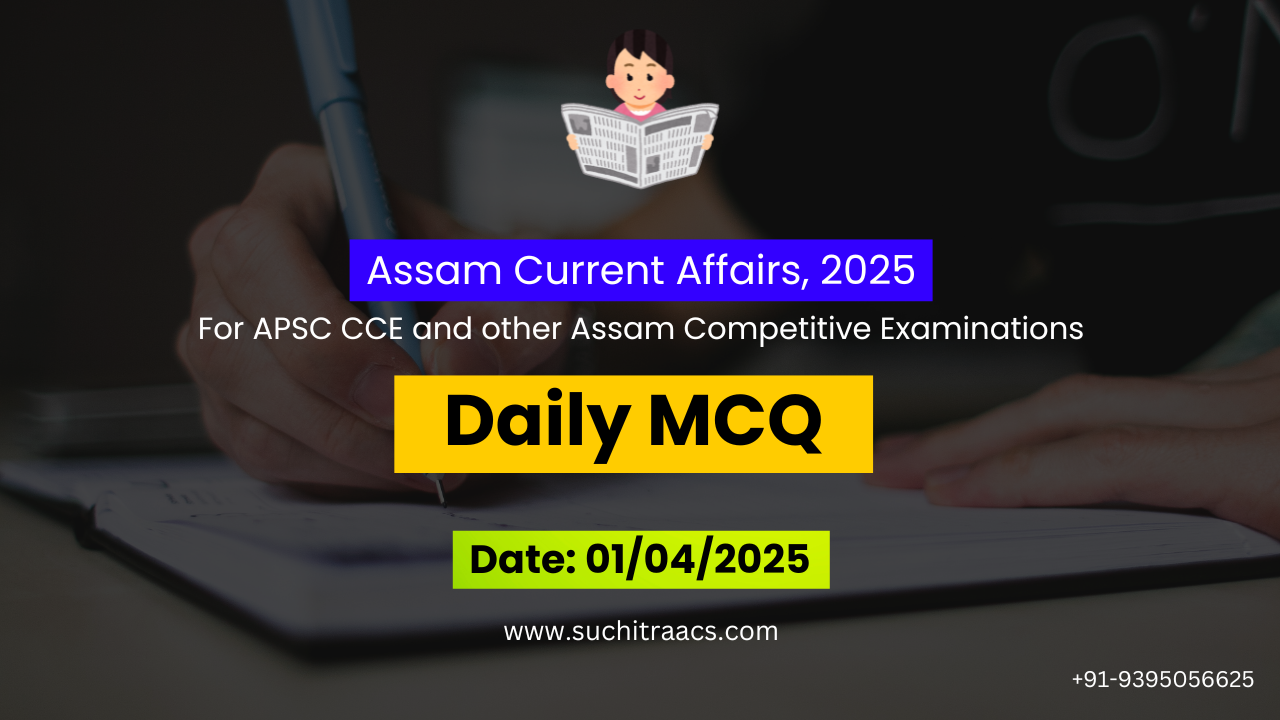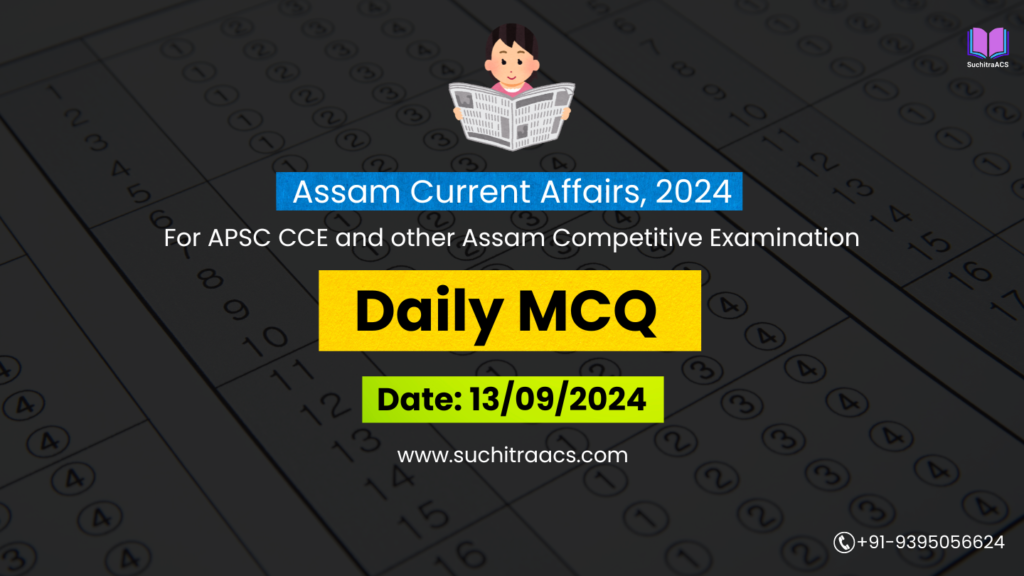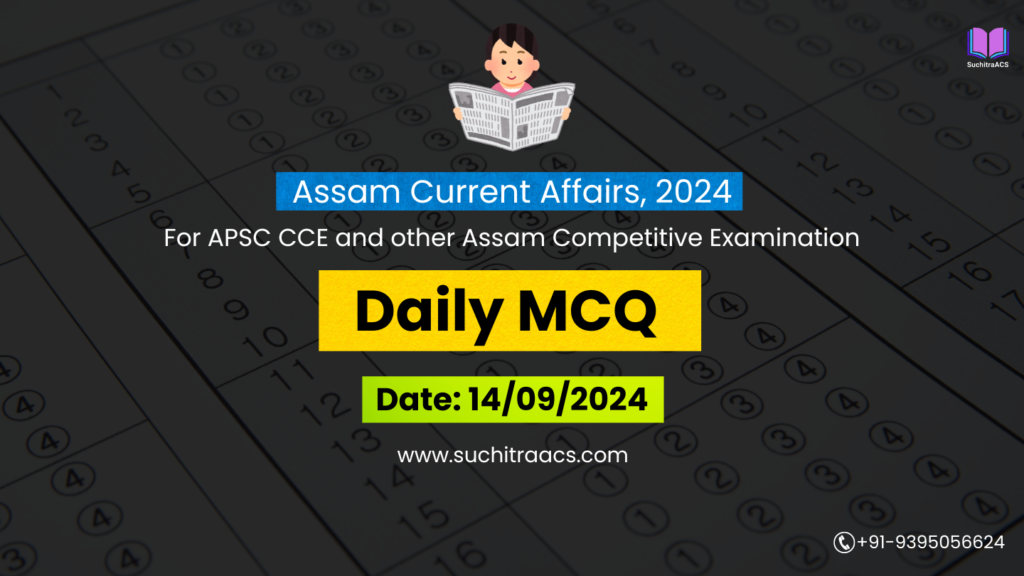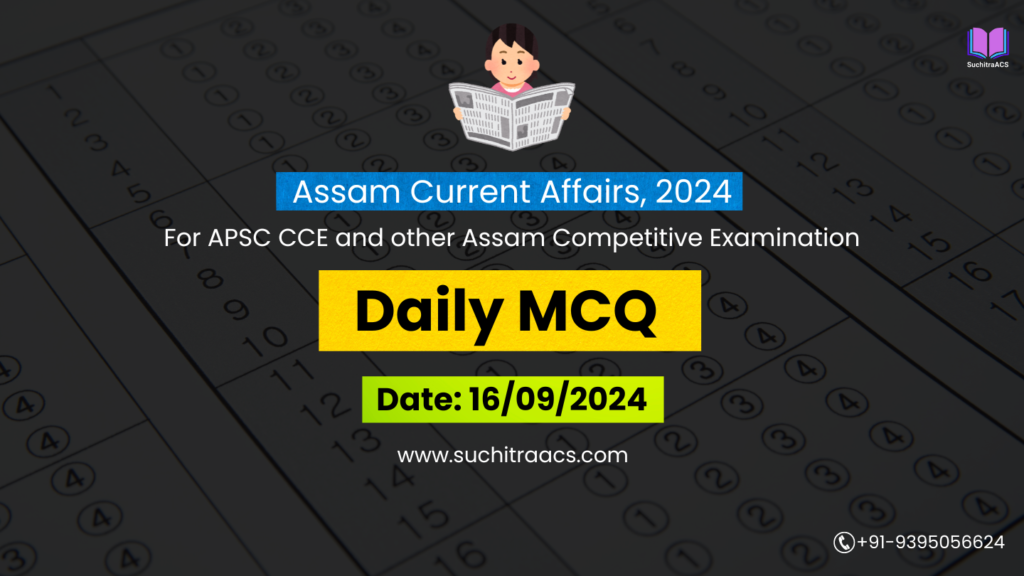APSC MCQs / APSC Prelims Practice Questions based on Assam Tribune (Daily) – 01/04/2025
For APSC CCE and other Assam Competitive examinations aspirants, practicing Daily MCQs is vital. This blog covers most important Prelims questions from the Assam Tribune today (28-03-2025). These issues are key for both APSC Prelims syllabus, offering insights into the important topics of current affairs.
APSC MCQs / APSC Prelims Practice Questions (Date: 01/04/2025)
1. India-UAE Trade Relations Strengthen
Q1. The Comprehensive Economic Partnership Agreement (CEPA) between India and UAE primarily aims to:
a) Increase India’s imports from UAE
b) Boost bilateral trade and investment
c) Allow free movement of Indian workers to UAE
d) Establish a common currency between the two countries
✅ Answer: b) Boost bilateral trade and investment
📝 Explanation:
The India-UAE CEPA, signed in 2022, eliminates tariffs on key exports and enhances market access for both nations. It aims to increase bilateral trade to $100 billion within five years.
Q2. Which of the following commodities is the largest item of India’s exports to the UAE?
a) Crude oil
b) Gold and jewelry
c) Textiles
d) Wheat
✅ Answer: b) Gold and jewelry
📝 Explanation:
UAE is a major gold refining and trading hub, and India exports a significant amount of gold, jewelry, and gemstones. Crude oil is a major import from UAE, not an export.
Q3. Which major Indian port handles most of India’s trade with the UAE?
a) Chennai Port
b) Nhava Sheva (Jawaharlal Nehru Port)
c) Cochin Port
d) Paradip Port
✅ Answer: b) Nhava Sheva (Jawaharlal Nehru Port)
📝 Explanation:
Nhava Sheva (JNPT) is India’s largest container port and handles a major portion of India-UAE trade, especially in petroleum and gold imports.
Q4. UAE is India’s ____ largest trading partner as of 2024.
a) 1st
b) 2nd
c) 3rd
d) 4th
✅ Answer: c) 3rd
📝 Explanation:
As of 2024, UAE is India’s third-largest trading partner, after the USA and China, contributing to petroleum, gold, and technology trade.
Q5. The RuPay card and UPI payment system were launched in UAE to strengthen:
a) India’s soft power diplomacy
b) Remittances and digital trade payments
c) Tourism between both nations
d) Indian investments in Dubai real estate
✅ Answer: b) Remittances and digital trade payments
📝 Explanation:
India and UAE introduced RuPay and UPI in 2023 to facilitate digital transactions for Indian expatriates and strengthen bilateral fintech collaboration.
2. AI Regulation in India: Government’s Plan
Q6. Which Indian government body is primarily responsible for AI policy and regulation?
a) NITI Aayog
b) Ministry of Electronics and IT (MeitY)
c) Reserve Bank of India
d) Securities and Exchange Board of India
✅ Answer: b) Ministry of Electronics and IT (MeitY)
📝 Explanation:
MeitY is responsible for AI regulation, data privacy, and digital governance policies in India. NITI Aayog plays an advisory role in AI strategy.
Q7. India’s AI regulation framework is being developed under which initiative?
a) National AI Mission
b) Digital India Act
c) AI for All Initiative
d) Bharat AI Policy
✅ Answer: b) Digital India Act
📝 Explanation:
The Digital India Act aims to regulate AI, data privacy, cybersecurity, and digital economy governance in India.
Q8. Which of the following risks is NOT associated with AI adoption?
a) Algorithmic bias
b) Data security issues
c) Faster internet connectivity
d) Job displacement
✅ Answer: c) Faster internet connectivity
📝 Explanation:
While AI offers automation benefits, it also poses risks such as algorithmic discrimination, data breaches, and job displacement, but does not directly affect internet speed.
Q9. The “AI for All” initiative by the Indian government focuses on:
a) Restricting AI use in defense
b) Promoting AI education and skill development
c) Banning AI in social media
d) Creating an AI-based central surveillance system
✅ Answer: b) Promoting AI education and skill development
📝 Explanation:
AI for All promotes AI literacy and skill training in India, helping to build an AI-ready workforce for various sectors.
Q10. The European Union’s AI Act serves as a model for global AI regulation. What is its primary feature?
a) Complete ban on AI applications
b) Risk-based classification of AI systems
c) AI-driven national surveillance
d) AI replacing elected leaders
✅ Answer: b) Risk-based classification of AI systems
📝 Explanation:
The EU AI Act classifies AI systems into prohibited, high-risk, and low-risk categories based on their potential impact on human rights and safety.
3. Assam’s Flood Management Strategy: Challenges and Solutions
Q11. Which river is responsible for frequent and severe flooding in Assam?
a) Ganga
b) Yamuna
c) Brahmaputra
d) Teesta
✅ Answer: c) Brahmaputra
📝 Explanation:
The Brahmaputra River has a high sediment load, frequent embankment breaches, and glacial lake outbursts, making Assam prone to annual floods.
Q12. Which natural factor contributes most to Assam’s flood problem?
a) High population density
b) Shifting cultivation
c) Heavy monsoons and riverbank erosion
d) Industrial pollution
✅ Answer: c) Heavy monsoons and riverbank erosion
📝 Explanation:
Assam’s monsoon rainfall exceeds 2000 mm annually, leading to overflowing rivers and erosion, worsening the flood situation.
Q13. What is the main disadvantage of embankments in flood control?
a) They are too cheap
b) They block irrigation
c) They are prone to breaches and erosion
d) They increase fish population
✅ Answer: c) They are prone to breaches and erosion
📝 Explanation:
Most embankments in Assam fail due to riverbank erosion, leading to recurrent flooding despite government investments.
Q14. Which technology is being used for better flood forecasting in Assam?
a) Artificial Intelligence
b) Remote sensing and satellite imagery
c) Blockchain technology
d) Electric vehicles
✅ Answer: b) Remote sensing and satellite imagery
📝 Explanation:
ISRO and IMD use remote sensing to predict flood-prone zones and rainfall trends, improving early warning systems.
4. Expanding Rail Connectivity in Northeast India: Strategic and Economic Significance
Q15. The Northeast Frontier Railway (NFR) operates under which Indian ministry?
a) Ministry of Home Affairs
b) Ministry of Railways
c) Ministry of Transport
d) Ministry of External Affairs
✅ Answer: b) Ministry of Railways
📝 Explanation:
The Northeast Frontier Railway (NFR) oversees railway connectivity in the Northeastern states, enhancing trade and defense logistics.
Q16. What is the primary goal of the “Act East Policy” in relation to Northeast rail connectivity?
a) Develop tourist infrastructure
b) Strengthen defense logistics and trade with Southeast Asia
c) Provide free train services to citizens
d) Promote rural agriculture
✅ Answer: b) Strengthen defense logistics and trade with Southeast Asia
📝 Explanation:
The Act East Policy aims to connect Northeast India with Myanmar, Thailand, and ASEAN countries for strategic and economic benefits.
Q17. India’s first international railway link with Bhutan is expected to connect which Indian city?
a) Guwahati
b) Siliguri
c) Kokrajhar
d) Bongaigaon
✅ Answer: d) Bongaigaon
📝 Explanation:
A proposed Bongaigaon-Gelephu railway will be India’s first railway link with Bhutan, boosting trade and tourism.
 APSC Prelims Crash Course, 2025
APSC Prelims Crash Course, 2025
at most affordable rate in Assam!

🔔 Join Our WhatsApp Study Group!
For exclusive access to premium quality content, including study materials, current affairs, MCQs, and model answers for APSC CCE and other Assam competitive exams.
Click here to join: SuchitraACS Study WhatsApp Group
📚 Want to know more about SuchitraACS’s most affordable courses?
Click here to know more: SuchitraACS Courses for APSC CCE and Assam Competitive Examinations




